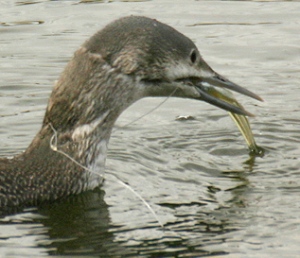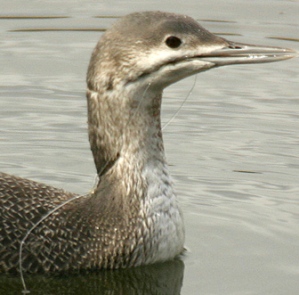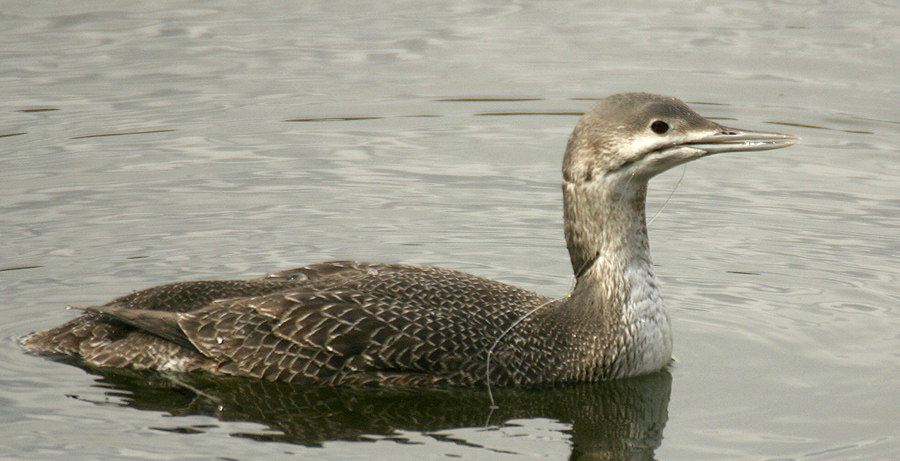Red-throated loon with fishing line

Red-throated loon, Chris Bosak all rights reserved
(More photos at end of this post)
I pulled into the parking lot at my place of work along the Norwalk River. As usual, I took the parking spot farthest away from the door so I could walk along the river to see what surprises it might hold.
On Tuesday afternoon, it was a red-throated loon. I was thrilled as loons usually are found closer to Long Island Sound and not this far up the river. On top of that the loon was close to the river’s edge, so I grabbed my camera. The loon dove under so I moved to the edge of the dock. It resurfaced fairly close so I snapped some photos. The photos will be servicable, I thought, despite the gray sky and gray reflection on the water. “Good enough for a quick ‘Walking to Work’ entry on this blog, anyway,” I thought as I walked to the office.
When I looked at the photos I soon discovered it wasn’t going to be a quick blog entry. The loon had fishing line around its head and mouth (see photos above and below). I was so thrilled to see this Arctic bird at my place of work and suddenly I was so disappointed to see that it had this human-made impediment. It’s hard to tell from the photos just how tangled or hooked the loon is. (Unless someone sees something I don’t, which is entirely possible.) It’s eating a fish in one of the photos so it’s obviously doing OK from that standpoint. But is there a hook attached to the line coming out of the loon’s mouth? Is the line wrapped in such a way that it’s going to break free soon _ or will it tighten on the loon?
If you have thoughts based on the photos, please let me know. Hit “contact me” above.
I’m an optimist, so I hope for the best for this bird. But there’s no denying that discarded fishing hooks and line is a serious problem for birds.
A few years ago, I wrote a “For the Birds” column and ran a photo of a dead belted kingfisher that was dangling between two trees helplessly tangled in fishing line and hooked in the wing. The New York Times recently ran an article about a city park where abandoned fishing line is causing bird deaths. (Norwalk’s Larry Flynn contributed a photo of a dead osprey for that article.)
The problem makes you think. Humans either cause or contribute to so many problems that birds face. Discarded fishing line is a tricky one. We’ve all had our fishing line snagged on a rock on the bottom of the lake or other body of water. We pull and tug and eventually the line breaks. We forget about it and tie on another hook, but the hook on that snapped line still poses a danger to birds that dive for small at the bottom of the water.
Then there’s the problem of discarded line tangled in trees. Most fishermen cut the line and start all over, not thinking twice about the line and hook dangling from the branches. That’s not a judgment of all fishermen, mind you, but we’ve all seen it enough to know that it’s widespread.
We, as fishermen, birders and outdoorspeople, can do something about it. If you see that line _ looking so impossibly tangled in the branches or on the shoreline _ try your best to get rid it it. It won’t always be easy, but think about the potential consequenses. That kingfisher would have been awfully glad someone took the effort to get rid of the fishing line and hook that caused its demise.
As for this loon. Who knows? As I said before, I hope for the best. Hopefully it will return to the Arctic in a few weeks and contribute to the continuation of the red-throated loon as a species.
Is that a realistic hope? Again, who knows?
Birds must have been so much happier before humans came around.

Red-throated loon, Chris Bosak all rights reserved

Red-throated loon, Chris Bosak all rights reserved

So sad, sorry to see this. And yes, people dont understand the impact of their “recreation” and how it can have a negative effects on birds and all wildlife.
Thank you for this blog. It is sad, and a very real problem for many birds of aquatic and riparian habitats. I am a raptor rehabilitator in MD, and I have received calls and rescued several Barred Owls entangled in fishing line. Gulls, Canada Geese and Great Blue Herons are often victims as well. The heavier bodied birds can break free but carry the line around with them like your red-throated loon. A friend and fellow rehabber I know, who is also a skilled paddler, has been successful in capturing and removing line from some geese and herons that became debilitated. That would certainly be more difficult with a diving bird.
Brown Pelicans will often congregate around popular fishing spots and actually steal and swallow fish, with hook and line, as the fisherman is reeling it in! In this case, if the fisherman doesn’t cut the bird free or the bird break free, rehabbers can often save them.
In the top photo it appears to me that the loon has the hook in the right side of its neck. We can only hope that it can go on as it seems to have done, catching fish, with no further complications from this handicap.